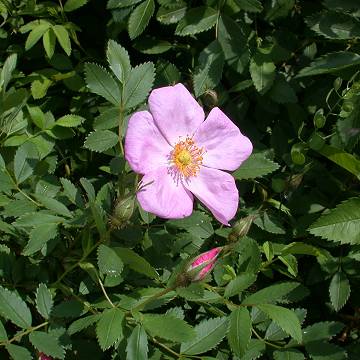

Rosa virginiana - (image 1 of 4)
Taxonomy
Family: Rosaceae
Habitat
Moist or dry soil.
Associates
Distribution
Southeast Canada and New England, NY south to NC, TN. Scattered populations in the Midwest.
Morphology
Woody perennial to 2 m. Twigs and prickles not tomentose; prickles slender, often decurved, the base flattened; internodal prickles often absent. Leaves pinnately compound; leaflets of flowering shoots mostly 9, glossy, half as wide as long, doubly serrate with teeth to 1 mm long; stipules entire or toothed, glandular-dentate. Flowers pink, solitary or few, on old wood; sepals spreading or reflexed, deciduous; styles distinct; pedicels and hypanthia glandular-hispid. Fruit a red hip.
Notes
Flowers late June to ?
Wetland indicator: Facultative
This plant has been introduced to areas outside its native range, including the Chicago region. Similar to R. carolina but often lacking prickles between the nodes.
References
Gleason, Henry A. and A. Cronquist. 1991. Manual of Vascular Plants of Northeastern United States and Adjacent Canada. Second Ed.
The New York Botanical Garden. Bronx, NY
Swink, F. and G. Wilhelm. 1994. Plants of the Chicago Region.
Indiana Academy of Science. The Morton Arboretum. Lisle, Illinois.
USDA, NRCS. 2002. The PLANTS Database, Version 3.5 (http://plants.usda.gov).
National Plant Data Center, Baton Rouge, LA 70874-4490 USA.
|
Michael Hough © 2005 |